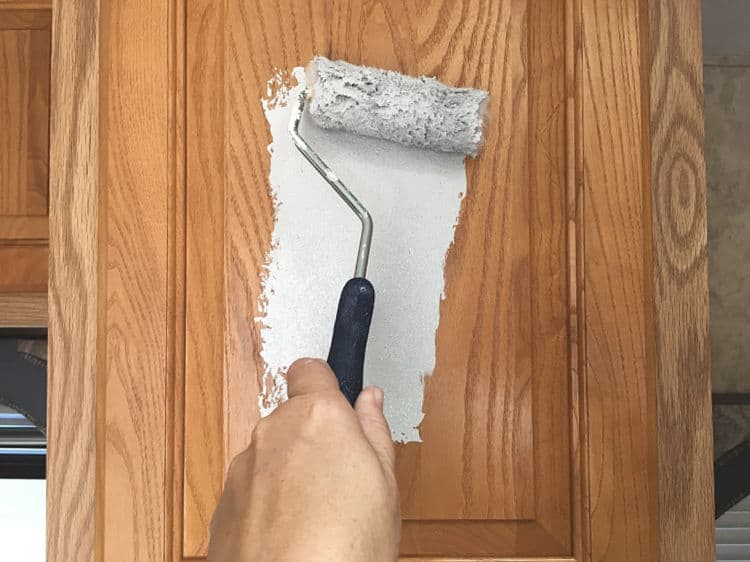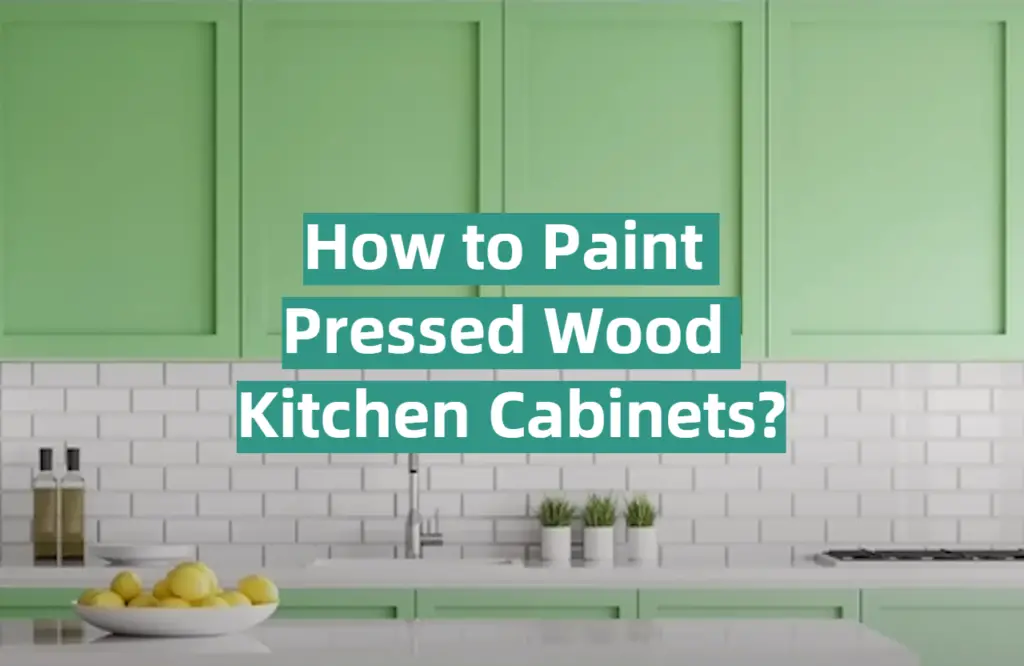The Appeal of Painted Pressed Wood Cabinets

Painted pressed wood cabinets have become a popular choice for kitchen renovations and new builds, offering a blend of affordability, versatility, and durability. They provide a cost-effective alternative to solid wood cabinets while still allowing for a wide range of design possibilities.
Benefits of Pressed Wood for Kitchen Cabinets, Painting pressed wood kitchen cabinets
Pressed wood, also known as engineered wood, is a popular choice for kitchen cabinets due to its many advantages.
- Cost-Effective: Pressed wood is generally less expensive than solid wood, making it an attractive option for budget-conscious homeowners.
- Stability and Strength: Modern manufacturing processes create strong and stable panels that resist warping and cracking, ensuring the longevity of your cabinets.
- Versatility: Pressed wood readily accepts paint, stain, and various finishes, allowing for a wide range of design options to match any kitchen style.
- Sustainability: Pressed wood often utilizes reclaimed wood or wood byproducts, promoting responsible forest management practices.
Comparison with Other Cabinet Materials
While pressed wood offers numerous advantages, it’s important to compare it with other common cabinet materials to make an informed decision.
| Material | Pros | Cons |
|---|---|---|
| Solid Wood | Natural beauty, durability, refinishable | Expensive, susceptible to warping and cracking, requires more maintenance |
| Painted Pressed Wood | Cost-effective, versatile, stable, sustainable | May not be as durable as solid wood, susceptible to scratches and dents |
| Thermofoil | Durable, moisture-resistant, easy to clean | Limited design options, may not be as aesthetically pleasing as painted wood |
Painting Techniques and Considerations

Transforming your pressed wood cabinets with a fresh coat of paint can breathe new life into your kitchen. While the process might seem daunting, it’s achievable with the right tools, techniques, and a little patience.
Surface Preparation
Proper surface preparation is crucial for a successful paint job. A well-prepared surface ensures that the paint adheres properly and lasts longer. Here’s a step-by-step guide for preparing your pressed wood cabinets for painting:
- Clean the Cabinets Thoroughly: Start by cleaning your cabinets with a degreaser to remove any grease, grime, or dirt. This will allow the paint to adhere better to the surface.
- Sand the Cabinets: Sanding helps create a smooth surface for the paint to adhere to. Use fine-grit sandpaper (120-grit) to remove any imperfections, gloss, or old paint. Sanding also helps to create a slightly rough surface that will improve paint adhesion.
- Fill in Any Gaps or Cracks: Use wood filler to fill in any gaps or cracks in the cabinets. This will create a smooth and even surface for painting.
- Prime the Cabinets: Priming helps to seal the wood and create a smooth, even surface for the paint to adhere to. Use a primer specifically designed for pressed wood, which will help prevent the paint from peeling or chipping.
Types of Paint
Choosing the right paint is essential for achieving a durable and long-lasting finish. Here are some paint types suitable for pressed wood cabinets:
- Acrylic Latex Paint: This type of paint is a popular choice for kitchen cabinets because it is durable, easy to clean, and comes in a wide range of colors. It dries quickly and is low-odor, making it ideal for indoor use.
- Oil-Based Paint: Oil-based paints are known for their durability and resistance to moisture and stains. However, they take longer to dry and have a strong odor, which may not be suitable for everyone.
- Epoxy Paint: Epoxy paint is a highly durable and moisture-resistant option, making it ideal for high-traffic areas like kitchens. It is also known for its smooth and glossy finish.
Best Practices for Achieving a Smooth and Durable Finish
Here are some best practices to help you achieve a smooth and durable finish when painting your pressed wood cabinets:
- Use a High-Quality Paintbrush: A good quality paintbrush will help you achieve a smooth and even finish. Choose a brush specifically designed for latex or oil-based paint, depending on the type of paint you are using.
- Apply Thin Coats: Apply thin coats of paint to avoid drips and runs. Multiple thin coats will provide a better finish than one thick coat.
- Let Each Coat Dry Completely: Allow each coat of paint to dry completely before applying the next coat. This will ensure that the paint dries evenly and adheres properly.
- Sand Lightly Between Coats: Sand lightly between coats to create a smooth surface for the next coat. Use fine-grit sandpaper (220-grit) to avoid damaging the previous coat.
- Use a Paint Roller for Large Surfaces: Use a paint roller to cover large surfaces quickly and efficiently. Choose a roller with a nap length that is appropriate for the type of paint you are using.
- Protect Your Work Area: Cover your work area with drop cloths or plastic sheeting to protect it from paint splatters.
Paint Finishes and Their Characteristics
| Paint Finish | Characteristics |
|---|---|
| Matte | Flat, non-reflective finish that hides imperfections well. |
| Eggshell | Slightly sheen finish with a soft, velvety look. |
| Satin | A smooth, low-luster finish that is easy to clean. |
| Semi-Gloss | A more reflective finish that is durable and easy to clean. |
| Gloss | The highest gloss level, offering a shiny and reflective finish. |
Style and Design Considerations: Painting Pressed Wood Kitchen Cabinets

Painting pressed wood kitchen cabinets offers a fantastic opportunity to transform your kitchen’s aesthetic. Beyond the practical benefits of updating the look, you can unleash your creativity and design a space that reflects your personal style. This section delves into the various style and design considerations that will help you achieve your desired kitchen transformation.
Popular Paint Colors for Kitchen Cabinets
Choosing the right paint color for your kitchen cabinets is crucial. The color can significantly impact the overall feel of the space, influencing everything from the perceived size to the mood. Here are some popular paint colors for kitchen cabinets:
- White: A timeless classic, white cabinets create a clean and airy atmosphere, making the kitchen feel larger and brighter. It pairs well with various countertop materials and backsplash options, providing a versatile backdrop for different styles.
- Gray: A popular choice for modern kitchens, gray offers a sophisticated and neutral backdrop. It can range from light grays that create a calming effect to darker grays that add a touch of drama. Gray complements both warm and cool tones, making it a versatile choice.
- Black: Black cabinets add a bold and dramatic touch to the kitchen. They create a sense of elegance and sophistication, especially when paired with lighter countertops and backsplashes. Black can make a small kitchen feel more intimate, but it can also make it appear smaller.
- Blue: Blue cabinets can evoke a sense of calm and tranquility, making the kitchen a relaxing space. Lighter shades of blue create a breezy and airy feel, while deeper blues add a touch of sophistication. Blue pairs well with natural elements like wood and stone.
- Green: Green cabinets bring a touch of nature into the kitchen. Lighter shades of green create a refreshing and vibrant feel, while darker shades add a touch of elegance. Green complements a wide range of countertop materials, from white to black.
Incorporating Different Painting Techniques
Beyond choosing a color, you can explore various painting techniques to create unique styles and textures for your cabinets.
- Distressed Finish: This technique involves creating a worn and aged look by sanding down the paint in certain areas. This technique is popular for creating a farmhouse or cottage-style kitchen.
- Glazing: Glazing involves applying a translucent layer of paint over the base coat, creating depth and dimension. This technique can be used to highlight details or create a subtle shimmer.
- Metallic Finish: Metallic paints add a touch of glamour and sophistication to kitchen cabinets. They can be used to create a modern or contemporary feel.
- Two-Tone Painting: This technique involves painting the cabinets in two different colors, creating a visually interesting effect. You can use contrasting colors or shades of the same color for a more subtle look.
Using Stencils and Patterns
Stencils and patterns provide an easy way to add decorative elements to your kitchen cabinets. They allow you to create intricate designs without the need for freehand painting.
- Geometric Patterns: Geometric patterns, such as stripes, chevrons, or polka dots, add a modern and playful touch to kitchen cabinets. They can be used to create a focal point or to break up large areas of color.
- Floral Motifs: Floral stencils can add a touch of romance and elegance to the kitchen. They are particularly well-suited for traditional or farmhouse styles.
- Damask Patterns: Damask patterns, characterized by intricate and repeating designs, create a sophisticated and elegant look. They are often used in formal dining rooms, but they can also add a touch of luxury to a kitchen.
Creating a Cohesive Kitchen Design
To create a cohesive kitchen design with painted pressed wood cabinets, it’s essential to consider the overall style and theme you want to achieve.
- Matching Hardware: Choosing the right cabinet hardware is crucial for creating a cohesive look. Hardware should complement the paint color and style of the cabinets. For example, brushed nickel hardware would complement a modern kitchen with gray cabinets, while antique brass hardware would be more suitable for a traditional kitchen with white cabinets.
- Countertop and Backsplash Coordination: The countertop and backsplash should also complement the paint color and style of the cabinets. For example, a white countertop and subway tile backsplash would create a classic and timeless look with white cabinets. A black countertop and patterned backsplash would add a touch of drama to a kitchen with black cabinets.
- Lighting: Lighting plays a significant role in creating the desired ambiance in the kitchen. Pendant lights over the island or under-cabinet lighting can highlight the beauty of painted cabinets and create a warm and inviting atmosphere.
Painting pressed wood kitchen cabinets can be a fun DIY project, but it’s important to prep the surface properly. You’ll want to make sure the cabinets are clean and free of grease, and then sand them down to create a smooth finish.
If you’re looking for a little inspiration for your kitchen makeover, why not check out this stunning 4 bedroom apartment noosa ? The modern kitchen design features beautiful cabinets that could give you some great ideas for your own project.
Once you’ve got your cabinets prepped and ready to go, you can choose your paint color and get to work!
Painting pressed wood kitchen cabinets can be a fun DIY project, but it’s important to prep the surface properly for a smooth, long-lasting finish. While I was working on my kitchen cabinets, I was also looking for a comfy place to sit while getting dressed in the morning, and that’s when I stumbled upon the serena upholstered bedroom bench.
It’s so stylish and comfortable, and it really completes the look of my bedroom. Back to the cabinets, though, remember to use a primer specifically designed for pressed wood to prevent the paint from peeling or chipping.